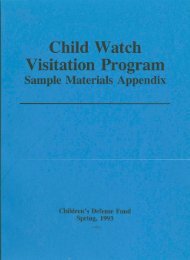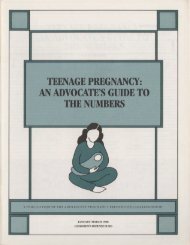child care - Digital Library Collections
child care - Digital Library Collections
child care - Digital Library Collections
You also want an ePaper? Increase the reach of your titles
YUMPU automatically turns print PDFs into web optimized ePapers that Google loves.
....._--"T..;H;;..;;;.E STATE OF AMERICA'S CHILDREN YEARBOOK 1998<br />
Cutoffs offood stamps and Medicaid continue<br />
to accompany the loss ofcash aid in other states as<br />
the 1996 federal law is implemented. Why the big<br />
drolHlff? In part, families accustomed to getting<br />
cash aid, food stamps, and Medicaid as a package<br />
may not understand that they are still eligible. For<br />
some, going to the welfare office every three<br />
months to certify continuing eligibility is a difficult<br />
hoop to jump through. Parents who are working<br />
may be unable to get to welfare offices open only<br />
during regular business hours; others may fmd<br />
transportation expensive or unavailable. During<br />
the debate surrounding passage ofthe 1996 welfare<br />
law, proponents argued that although cash aid<br />
would be limited, families would be able to count<br />
on food stamps and Medicaid as their safety net.<br />
For significant numbers of families, the net is in<br />
tatters.<br />
Immigrants. The 1996 federal welfare law denied<br />
Supplemental Security Income and food<br />
stamps to most legal immigrants until they become<br />
citizens, and gave states the option of continuing<br />
Medicaid and TANF for immigrants here legally at<br />
the time the law passed. Immigrants who entered<br />
the country later (after August 1996) were barred<br />
from receiving TANF or Medicaid for five years.<br />
States could opt to provide these benefits after five<br />
years, but they were also free to deny them permanently<br />
(even to those immigrants who had entered<br />
the country before the law was enacted).<br />
By calling attention to the plight ofelderly and<br />
disabled immigrants who had no hope of making<br />
up their lost SSI or food stamp income, advocates<br />
succeeded in reversing some of the cuts in 1997.<br />
Immigrants in the country legally as of August<br />
1996 can now receive SSI if they were receiving it<br />
then or if they subsequently develop a disability.<br />
They remain ineligible for food stamps. Advocates<br />
pushing for legislation to change this have been<br />
encouraged by a partial restoration proposed in the<br />
President's FY 1999 budget. All states except Alabama<br />
have opted to continue TANF for legal immigrants.<br />
Twelve states (California, Florida, Illinois,<br />
Massachusetts, Maryland, Minnesota, Nebraska,<br />
New Jersey, New York, Rhode Island, Texas, and<br />
Washington) are also providing aid in some form to<br />
at least some of the legal immigrants denied food<br />
stamps under federal law.<br />
Children with disabilities. The 1996 federal law<br />
made it more difficult for poor <strong>child</strong>ren with disabilities<br />
to qualify for Supplemental Security Income.<br />
About 288,000 case reviews were required<br />
to determine whether <strong>child</strong>ren receiving SSI under<br />
the older standards would still qualify. As states<br />
have conducted these reviews under rules established<br />
by the Social Security Administration, they<br />
have denied assistance to large numbers of <strong>child</strong>ren.<br />
As of December 1997 about 263,000 cases<br />
(more than 90 percent) had been reviewed, resulting<br />
in the cutoff of benefits for more than<br />
half-about 135,000 <strong>child</strong>ren. The denial rate has<br />
varied widely among states, with nine states terminating<br />
assistance in 70 percent or more of the<br />
reviewed cases.<br />
New applicants for SSI have even greater problems.<br />
Although the eligibility criteria emphasize<br />
matching a <strong>child</strong>'s condition to those on an official<br />
medical list, the new law expressly allows the Social<br />
Security Administration to assess whether the<br />
limitations of a <strong>child</strong>'s functioning are equivalent<br />
to conditions on the official list. The Clinton Administration<br />
was interpreting this provision so restrictively<br />
that between August 1996, when the law<br />
passed, and October 1997, only 32.2 percent ofthe<br />
<strong>child</strong>ren applying were approved. This was below<br />
the 42.8 approval rate in 1989, when an even more<br />
stringent eligibility standard was in effect. One indication<br />
of the overzealous restriction ofbenefits is<br />
that as of fall 1997, <strong>child</strong>ren in the first phase of<br />
appealing their denials succeeded 58 percent ofthe<br />
time. Prior to the new law, only about 10 percent of<br />
denials were reversed in the flfSt stage ofappeal.<br />
In a victory for <strong>child</strong>ren with disabilities,<br />
Social Security Administration Commissioner<br />
Kenneth Apfel agreed to review the agency's implementation<br />
ofthe new law. He concluded in December<br />
1997 that procedures were flawed, especially in<br />
mental retardation cases. The agency announced<br />
that it would review all of those denials, plus other<br />
cases with a high likelihood of error, including<br />
12 CHILDREN'S DEFENSE FUND














